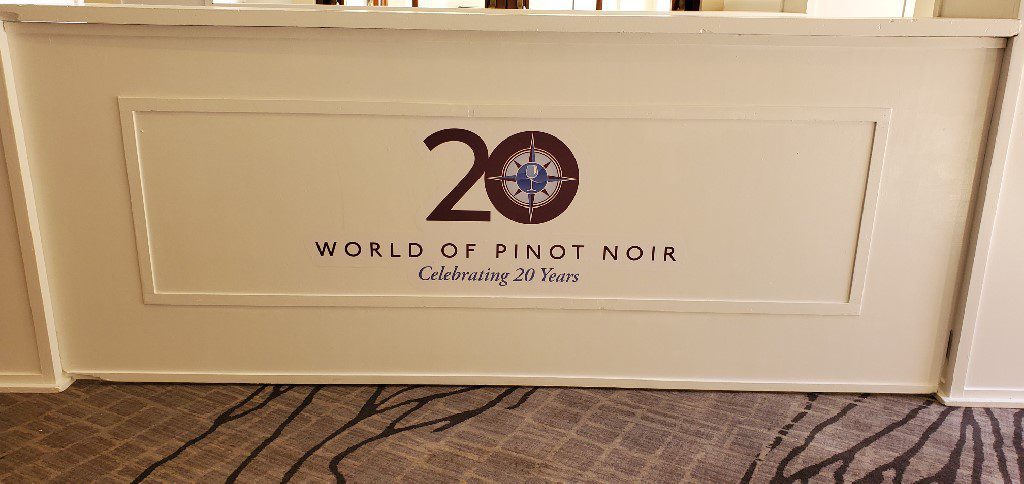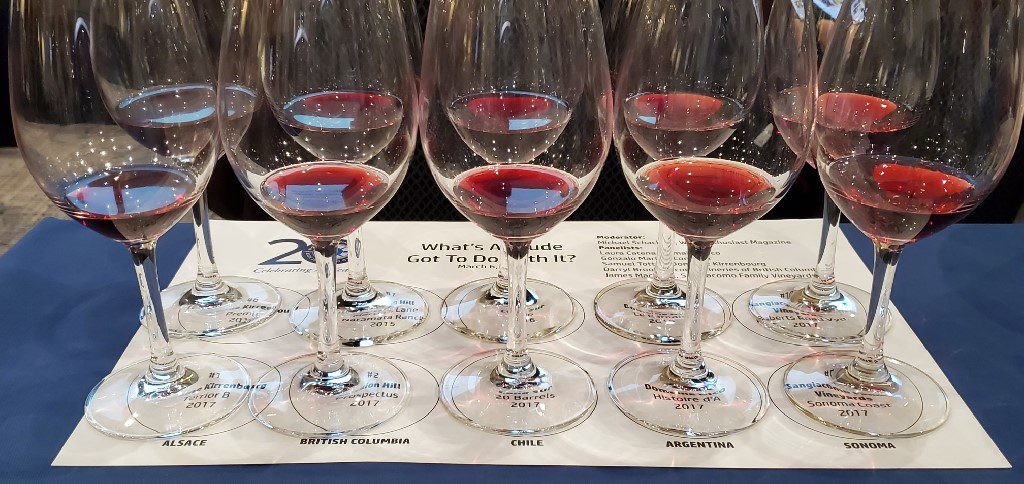

21 Apr World of Pinot Noir celebrates 20 years
One annual event I look forward to every year is World of Pinot Noir. As World of Pinot Noir celebrated its 20th anniversary, Pinot Noir producers from around the world were joined by Pinot Noir lovers, such as myself. I wrote about the 20th Annual World of Pinot Noir in the Napa Valley Register and you can read it here.
Pinot Noir is a fickle grape. The thin-skinned grape produces tight clusters and likes to ripen late. It is particular about the soil it is planted in and picky about the climate it grows in.
But Pinot Noir produces one of the most delicate, elegant and beautiful wines that can at times be ethereal. Wine critic Allen Meadows, also known as Burghound, once wrote, “It has been said that those who love Pinot Noir are the most passionate of all wine lovers. Pinot enthusiasts will spend hours trying to find a few bottles of exceptionally rare wines and freely spend considerable sums on crisscrossing the globe to commune with others who share their passion.”
For the past 20 years, wine producers and wine enthusiasts from around the world have come together at World of Pinot Noir to celebrate the Pinot Noir grape. World of Pinot Noir was first started in 2001 by a small but dedicated group of winemakers from the San Luis Obispo and Santa Barbara County wine regions. What started as a small event at The Cliffs Resort in Shell Beach, California, has turned into an event at the Ritz-Carlton in Santa Barbara that features 200 participating wineries from around the world and attracts over 2,000 attendees.
Norm Yost, owner and winemaker at Flying Goat Cellars in Santa Barbara County, has been coming to World of Pinot Noir since 2002. He has been on the Advisory Board and has been on the World of Pinot Noir Board for the past 10 years. What Norm loves about World of Pinot Noir is “pouring with friends and exchanging and sharing ideas and wines.”
David Strada, the marketing manager for New Zealand Wine Growers, has been attending World of Pinot Noir for more than a decade. He recalled calling the organizers many years ago and expressing interest in including New Zealand Pinot Noirs. “We were welcomed with open arms,” he said, “and New Zealand has been a part of the event ever since.”
Wayne Bailey, proprietor of Oregon wineries Youngberg Hill and Bailey Family Wines, attended World of Pinot Noir for his first time this year. Not only does he see it as good exposure for wineries, but he said he enjoyed meeting “so many people interested in Pinot Noir who are excited to explore beyond their local areas.”
Another first timer to the event was winemaker Megan Baccitich of the recently released Geodesy Wine, who said the event was “fun but also exciting that there is enough diversity out their to warrant an event dedicated to Pinot Noir.”
I attended my first World of Pinot Noir in 2005 in Shell Beach and then returned in 2015 when it moved to Santa Barbara. I have been going every year since and will never miss it. It brings together people who share common interests and passions and is a chance to taste wines from familiar wineries and be introduced to new ones.
World of Pinot Noir showcases Pinot Noir from the best wine regions in the world. This year, there were wineries from Napa, Sonoma, Oregon, Monterey, Mendocino, Santa Barbara County, San Luis Obispo County, Santa Cruz, as well as Alsace, Alto Adige, Argentina, British Columbia, Chile, New Zealand, and, of course, Burgundy.
While I tasted many of the wines from each of these regions at the Grand Tasting that takes place over two days, I was able to get a global perspective on Pinot Noir in a seminar that featured wineries from Alsace, British Columbia, Chile, Argentina and Sonoma and also introduced me to some new wineries.
— Domaine Kirrenbourg, Alsace
Managing Director Samuel Tottoli introduced Domaine Kirrenbourg, a new estate founded in 2015. Located in Kaysersberg in the center of Alsace in the eastern part of France, close to Germany, the estate is located at the foot of the Vosges Mountains, which protect the vineyards. Alsace is one of the driest regions in France and where Domaine Kirrenbourg is located is even drier as a result of the protective mountains. The vineyards at Domaine Kirrenbourg are Grand Cru vineyards that consist of 13 different soils, including granite, and 20 different terroirs. The estate produces Pinot Noir and Riesling and 75 percent of the production is red wine.
—Domaine Kirrenbourg Terroir B 2017 – Deep granitic soils result in vines that do not stress. The resulting wine has notes of raspberry, plum, dusty earth and dried flowers. The wine is bright with tension and high acidity that tingles on the tongue.
—Domaine Kirrenbourg Premier 2017 – The grapes for this wine come from a higher altitude and grow in marl and limestone soils. This cold area results in early maturity and the final wine has a perfumed nose with deep fruit notes. On the palate the wine has bright acidity and soft tannins.
— Iconic Wines of British Columbia
Darryl Brooker is the managing director of Iconic Wines of British Columbia, a group of wineries based in the Okanagan Valley, British Columbia, Canada. The Okanogan Valley is only 200 kilometers in length and currently only 10,000 acres are currently planted. Yet despite the size, it is a diverse area. The southern part is warmer like Walla Walla, Washington. In the middle of the valley is a lake that offers a moderating effect. The northern part offers more altitude, cooler temperatures and a diurnal range. Mission Hill Family Estate, one of the members of Iconic Wines of British Columbia, has eight single organically farmed vineyard sites planted to Pinot Noir vines that range from 20-25 years in age.
—Mission Hill Prospectus 2017 – A blend of 3 vineyards, including one that is close to the lake and one that is at the top of plateau above the lake, this wine has bright aromas of wild strawberry, raspberry and plum and finishes with a touch of spice.
—Mission Hill Martin’s Lane Naramata Ranch 2015 – This wine has beautiful lavender and floral notes that mix with ripe fruit notes and an herbal touch.
— Cono Sur, Casablanca Valley, Chile
Part of the large company Concha ye Toro, Cono Sur was founded in 1993 in the Casablanca Valley. Regional Director Gonzalo Marina explained that in Chile they look less for altitude and more for proximity to the ocean. In the Casablanca Valley, the cooler temperatures result in good acidity and the deep red clay and granitic soils result in a lot of minerality in the wine. After visiting Burgundy, Cono Sur’s winemaker established the ultimate goal: to make the best Chilean Pinot Noir using French knowledge.
—Cono Sur 20 Barrels 2017 – Made from a blend of 85 percent of the Pinot Noir from Casablanca, 15 percent of the Pinot Noir from San Antonio, a region more exposed to the ocean, the wine is rich with spice notes but also bright.
—Cono Sur Ocio 2016 – Fresh and bright with sour cherry notes, this wine is balanced with a lovely texture on the palate.
— Domaine Nico, Uco Valley, Argentina
Laura Catena, Managing Director of Bodega Catena Zapata and Luca Winery is the founding owner of Domaine Nico, named after her daughter, Nico. She wanted to make the grape that she loves and looked for high altitude to a find cooler climate. She first planted Pinot Noir in the early 1990s and it took 15 years to learn how to make it. There are 25 hectares planted in soils that include stony soils. With more age on the vines, the Pinot Noir is coming into its own and expresses terroir.
—Domaine Nico Histoire d’A 2017 – Sourced from two vineyards, one at 5,000-foot elevation and one at 5,5000 feet, the wine is sexy and spicy.
—Domaine Nico Le Paradis 2016 – Elegant with a beautifully aromatic nose, on the palate the wine has sandy tannins with a little grip and a long lingering finish.
— Sangiacomo Family Vineyards, Sonoma
Sangiacomo is a recognizable name in Sonoma. The family has been farming since 1927 and planted vines in 1969. Today, they have 1600 acres of vines across 14 vineyards, many of which are contiguous. Located primarily in the Los Carneros AVA, the first appellation in the state of California designated for weather and not politics, it is a cool area with a strong maritime influence, fog and occasional sun in summer. The third generation of the Sangiacomo Family started making wine in 2016 with James MacPhail as the winemaker.
—Sangiacomo Family Vineyards Sonoma Coast 2017 – Made from a blend of vineyards, the wine has dusty lavender aromas and soft drying tannins with a lovely mid-weight on palate.
—Sangiacomo Family Vineyards Roberts Road Vineyard 2017 – The Roberts Road Vineyard is located across the street from Gap’s Crown and you can smell the coolness of the region as well as fruit and spice notes.
Read the original story in the Napa Valley Register.










